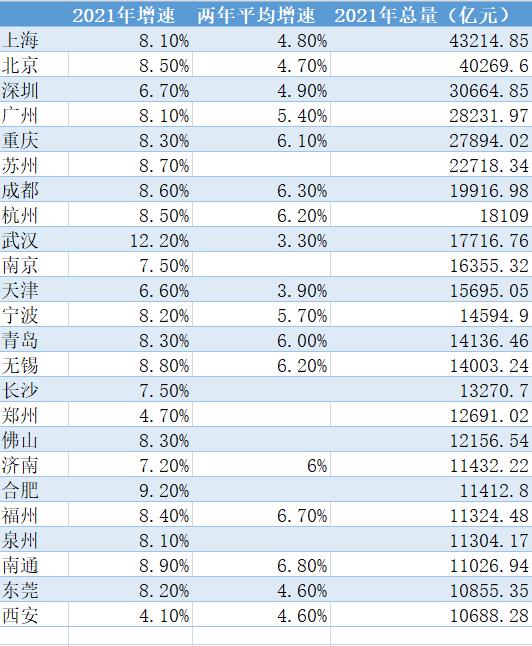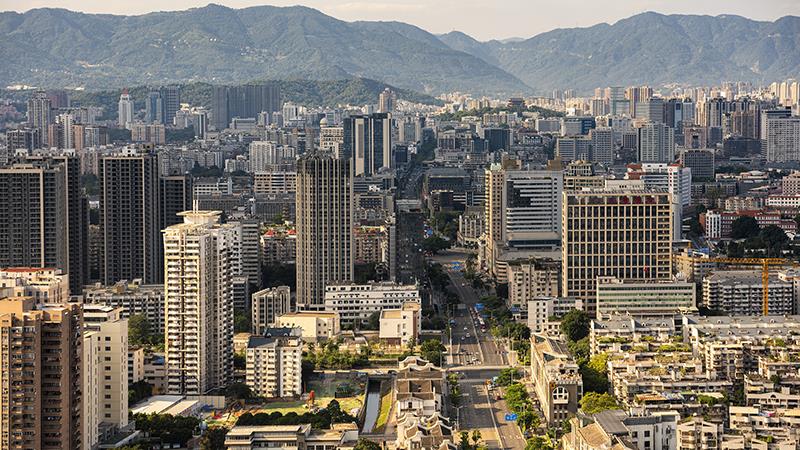The economic data of various places in 2021 have been released, and the seating of cities with a trillion yuan GDP as the spire of China city has also been scheduled. The competitive cities have maintained a relatively stable position, but the new members have set off a ranking competition and become a "spoiler" force in the trillion-dollar city club.
The top ten pattern remained stable.
In 2021, Dongguan became a city club with a GDP of one trillion yuan, and its membership increased to 24. The total GDP of 24 cities in 2021 accounted for 38.4% of the country, close to 40% of the country. It shows the growth pole role of these cities in the national and regional economy.
In terms of distribution, among the 24 trillion-yuan cities, 18 are southern cities and only 6 are from the north, namely Beijing, Tianjin, Qingdao, Zhengzhou, Jinan and Xi ‘an. Among the top ten cities, only one city is Beijing. Guangdong and Jiangsu each have four trillion-yuan cities. The ranking pattern of trillion-dollar cities also reflects the current development difference between North and South.
Among the northern cities, the growth rate of Tianjin, Zhengzhou and Xi ‘an is low, especially in Zhengzhou and Xi ‘an, which suffered from floods and epidemics, only increased by 4.7% and 4.1% respectively. As a result, the gap between Zhengzhou and Foshan has narrowed from 120 billion yuan to more than 50 billion yuan, while Xi ‘an has fallen to 24 th place, not only falling in the ranking, but also being surpassed by newly promoted Dongguan.
Cities with GDP exceeding one trillion yuan in 2021

In fact, compared with the ranking in 2020, the positions of the top 17 have not changed. What has changed is the six cities with a GDP of one trillion yuan in 2020 and the newly joined Dongguan in 2021. The rankings of some seemingly competitive cities remain stable, such as Guangzhou and Chongqing, Wuhan and Hangzhou, Nanjing and Tianjin.
The gap between Guangzhou and Chongqing will be reduced to less than 1.7 billion yuan in 2020, and the competition between Guangzhou and Chongqing as the "fourth city" has become the focus of attention. However, in 2021, Guangzhou led Chongqing by more than 30 billion yuan and defended its position as the "fourth city". It is expected that the economic aggregate between Chongqing and Guangzhou will still be relatively close in the next few years.
The gap between Wuhan and Chengdu, which were originally highly competitive, will widen in 2020 because of the impact of the epidemic. In 2021, the GDP of Chengdu and Wuhan were 1,991.698 billion yuan and 1,771.676 billion yuan respectively. The GDP data of Wuhan in 2021 happens to be the GDP of Chengdu in 2020 (1,771.67 billion yuan), which is equivalent to Chengdu leading Wuhan for one year.
The competitor who formed CP with Wuhan also changed from Chengdu to Hangzhou. In 2020, Hangzhou surpassed Wuhan, leading by about 50 billion yuan. Although Wuhan recovered its vitality in 2021, the gap between Wuhan and Hangzhou has narrowed compared with 2020, and there is still a gap of 40 billion yuan. Around the eighth position, Wuhan and Hangzhou are expected to continue the stalemate competition for several years.
Nanjing will surpass Tianjin to rank among the top ten in 2020. Although it was hit by the epidemic in mid-2021, Nanjing still defended its position in the top ten and still led Tianjin by 66 billion yuan. Judging from the growth momentum, Nanjing’s growth rate also keeps ahead. In 2021, Nanjing and Tianjin increased by 7.5% and 6.6% respectively.
Although the ranking is basically unchanged, it has differentiated into a new level in the trillion-dollar club: Shanghai and Beijing have joined hands to cross 4 trillion yuan, Shenzhen has also exceeded 3 trillion yuan, and Chengdu is only a stone’s throw from 2 trillion yuan. In 2022, Guangzhou and Chongqing are expected to cross the threshold of 3 trillion yuan, while Chengdu, Hangzhou and Wuhan are likely to exceed 2 trillion yuan.
The strategic effect of strengthening the province is obvious
Six new members in 2020 have changed the ranking of the Trillion City Club. Among them, Fuzhou, Hefei and Jinan rose by 3, 1 and 1 respectively, while Quanzhou, Nantong and Xi ‘an dropped by 3, 1 and 2 respectively. The cities that have risen in position are the cities that have implemented the strategy of strengthening the province, while Quanzhou and Nantong are both ordinary prefecture-level cities in the province.
In fact, the total amount of these cities is very close. The GDP of Quanzhou, Jinan, Hefei, Nantong, Xi ‘an and Fuzhou in 2020 was 1,015.8 billion, 1,014 billion, 1,004.5 billion, 1,002.03 billion and 1,002 billion yuan respectively, and in 2021 it was 1,130.417 billion, 1,143.222 billion, 1,141.28 billion respectively.
Fuzhou is the most unexpected dark horse. In 2020, Fuzhou is still at the bottom of the trillion-dollar city. In the first three quarters of 2021, Fuzhou (763.198 billion yuan) was still backward, which was more than 700 million yuan lower than the unsatisfactory performance of Xi ‘an. However, Fuzhou eventually surpassed Xi ‘an, Nantong and Quanzhou in one fell swoop, rising by three places, and it is also the city with the largest increase in ranking among trillions of cities.

Fuzhou’s "black" lies not only in the "sneak attack" of the ranking, but also in its brave performance in the fourth quarter. Comparing the data of the first three quarters, it can be seen that in the fourth quarter of 2021, Fuzhou’s GDP increased by 369.25 billion yuan, almost half of its total in the first three quarters, and the fourth quarter accounted for more than 32.6% of the whole year. In most areas, GDP in the fourth quarter accounted for about 28% in the whole year.
Not only that, in the ranking of 2021, Fuzhou historically surpassed Quanzhou, which has the highest economic aggregate in Fujian. For a long time, as the capital of Fujian, Fuzhou has an awkward position in the province. From the perspective of economic aggregate, its GDP is not as good as Quanzhou, the highest in the province. Judging from the administrative level of the city, it is not as good as Xiamen, a sub-provincial city, so its ranking in the province is not high.
In recent years, Fujian has vigorously implemented the strategy of strengthening the province. In 2021, the General Office of the Fujian Provincial Government issued "Several Opinions on Supporting Fuzhou to Implement the Strategy of Strengthening the Province", proposing that by 2025, Fuzhou’s GDP will reach more than 1.7 trillion yuan, with an average annual growth rate of more than 7%, the resident population will exceed 10 million, and the city’s primacy will be more than 25%.
Like Fuzhou, Hefei and Jinan are also cities that implement the strategy of strengthening the provincial association. In 2011 and 2019, Hefei and Jinan were the pioneers in adjusting the provincial association through administrative divisions by merging parts of Chaohu Lake and Laiwu City respectively. Through the implementation of the strategy of strengthening the province, the economic strength, city size and population of provincial capital cities have expanded rapidly.
Among the city clubs with a GDP of one trillion yuan, many cities are the beneficiaries of the strategy of strengthening the province. Except for 4 municipalities directly under the central government, 11 of the 20 cities are provincial capital cities, which basically implement the strategy of strengthening the province, including Chengdu and Xi ‘an in the west, Wuhan and Zhengzhou in the middle, and some eastern coastal capital cities such as Jinan, Nanjing and Fuzhou.
It is predicted that the strategy of strengthening the province will remain the main policy of regional economic development and regional competition in the future, and more and more provincial capitals are implementing it. The 12th Party Congress of Hunan Province held in November, 2021 also put forward the strategy of strengthening the province. Changsha will strive to achieve a GDP of 2 trillion yuan in 2026, an economic priority of over 30%, and a permanent population of over 12 million, so as to achieve a strong province in five years.